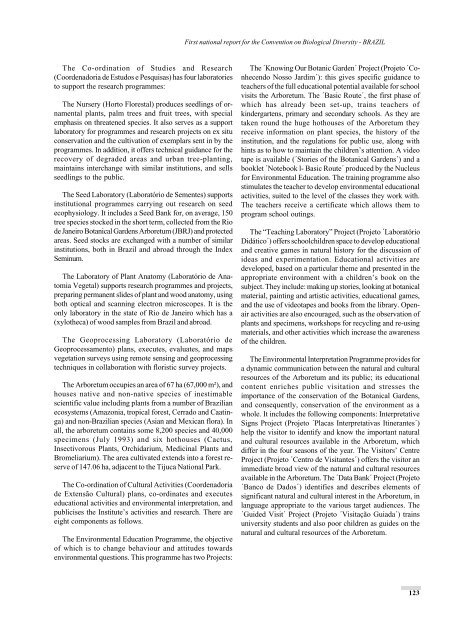Brazil (Part VIII, English version) - Convention on Biological Diversity
Brazil (Part VIII, English version) - Convention on Biological Diversity
Brazil (Part VIII, English version) - Convention on Biological Diversity
- No tags were found...
Create successful ePaper yourself
Turn your PDF publications into a flip-book with our unique Google optimized e-Paper software.
First nati<strong>on</strong>al report for the <str<strong>on</strong>g>C<strong>on</strong>venti<strong>on</strong></str<strong>on</strong>g> <strong>on</strong> <strong>Biological</strong> <strong>Diversity</strong> - BRAZILThe Co-ordinati<strong>on</strong> of Studies and Research(Coordenadoria de Estudos e Pesquisas) has four laboratoriesto support the research programmes:The Nursery (Horto Florestal) produces seedlings of ornamentalplants, palm trees and fruit trees, with specialemphasis <strong>on</strong> threatened species. It also serves as a supportlaboratory for programmes and research projects <strong>on</strong> ex situc<strong>on</strong>servati<strong>on</strong> and the cultivati<strong>on</strong> of exemplars sent in by theprogrammes. In additi<strong>on</strong>, it offers technical guidance for therecovery of degraded areas and urban tree-planting,maintains interchange with similar instituti<strong>on</strong>s, and sellsseedlings to the public.The Seed Laboratory (Laboratório de Sementes) supportsinstituti<strong>on</strong>al programmes carrying out research <strong>on</strong> seedecophysiology. It includes a Seed Bank for, <strong>on</strong> average, 150tree species stocked in the short term, collected from the Riode Janeiro Botanical Gardens Arboretum (JBRJ) and protectedareas. Seed stocks are exchanged with a number of similarinstituti<strong>on</strong>s, both in <str<strong>on</strong>g>Brazil</str<strong>on</strong>g> and abroad through the IndexSeminum.The Laboratory of Plant Anatomy (Laboratório de AnatomiaVegetal) supports research programmes and projects,preparing permanent slides of plant and wood anatomy, usingboth optical and scanning electr<strong>on</strong> microscopes. It is the<strong>on</strong>ly laboratory in the state of Rio de Janeiro which has a(xylotheca) of wood samples from <str<strong>on</strong>g>Brazil</str<strong>on</strong>g> and abroad.The Geoprocessing Laboratory (Laboratório deGeoprocessamento) plans, executes, evaluates, and mapsvegetati<strong>on</strong> surveys using remote sensing and geoprocessingtechniques in collaborati<strong>on</strong> with floristic survey projects.The Arboretum occupies an area of 67 ha (67,000 m²), andhouses native and n<strong>on</strong>-native species of inestimablescientific value including plants from a number of <str<strong>on</strong>g>Brazil</str<strong>on</strong>g>ianecosystems (Amaz<strong>on</strong>ia, tropical forest, Cerrado and Caatinga)and n<strong>on</strong>-<str<strong>on</strong>g>Brazil</str<strong>on</strong>g>ian species (Asian and Mexican flora). Inall, the arboretum c<strong>on</strong>tains some 8,200 species and 40,000specimens (July 1993) and six hothouses (Cactus,Insectivorous Plants, Orchidarium, Medicinal Plants andBromeliarium). The area cultivated extends into a forest reserveof 147.06 ha, adjacent to the Tijuca Nati<strong>on</strong>al Park.The Co-ordinati<strong>on</strong> of Cultural Activities (Coordenadoriade Extensão Cultural) plans, co-ordinates and executeseducati<strong>on</strong>al activities and envir<strong>on</strong>mental interpretati<strong>on</strong>, andpublicises the Institute’s activities and research. There areeight comp<strong>on</strong>ents as follows.The Envir<strong>on</strong>mental Educati<strong>on</strong> Programme, the objectiveof which is to change behaviour and attitudes towardsenvir<strong>on</strong>mental questi<strong>on</strong>s. This programme has two Projects:The ´Knowing Our Botanic Garden´ Project (Projeto ´C<strong>on</strong>hecendoNosso Jardim´): this gives specific guidance toteachers of the full educati<strong>on</strong>al potential available for schoolvisits the Arboretum. The ´Basic Route´, the first phase ofwhich has already been set-up, trains teachers ofkindergartens, primary and sec<strong>on</strong>dary schools. As they aretaken round the huge hothouses of the Arboretum theyreceive informati<strong>on</strong> <strong>on</strong> plant species, the history of theinstituti<strong>on</strong>, and the regulati<strong>on</strong>s for public use, al<strong>on</strong>g withhints as to how to maintain the children’s attenti<strong>on</strong>. A videotape is available (´Stories of the Botanical Gardens´) and abooklet ´Notebook l- Basic Route´ produced by the Nucleusfor Envir<strong>on</strong>mental Educati<strong>on</strong>. The training programme alsostimulates the teacher to develop envir<strong>on</strong>mental educati<strong>on</strong>alactivities, suited to the level of the classes they work with.The teachers receive a certificate which allows them toprogram school outings.The “Teaching Laboratory” Project (Projeto ´LaboratórioDidático´) offers schoolchildren space to develop educati<strong>on</strong>aland creative games in natural history for the discussi<strong>on</strong> ofideas and experimentati<strong>on</strong>. Educati<strong>on</strong>al activities aredeveloped, based <strong>on</strong> a particular theme and presented in theappropriate envir<strong>on</strong>ment with a children’s book <strong>on</strong> thesubject. They include: making up stories, looking at botanicalmaterial, painting and artistic activities, educati<strong>on</strong>al games,and the use of videotapes and books from the library. Openairactivities are also encouraged, such as the observati<strong>on</strong> ofplants and specimens, workshops for recycling and re-usingmaterials, and other activities which increase the awarenessof the children.The Envir<strong>on</strong>mental Interpretati<strong>on</strong> Programme provides fora dynamic communicati<strong>on</strong> between the natural and culturalresources of the Arboretum and its public; its educati<strong>on</strong>alc<strong>on</strong>tent enriches public visitati<strong>on</strong> and stresses theimportance of the c<strong>on</strong>servati<strong>on</strong> of the Botanical Gardens,and c<strong>on</strong>sequently, c<strong>on</strong>servati<strong>on</strong> of the envir<strong>on</strong>ment as awhole. It includes the following comp<strong>on</strong>ents: InterpretativeSigns Project (Projeto ´Placas Interpretativas Itinerantes´)help the visitor to identify and know the important naturaland cultural resources available in the Arboretum, whichdiffer in the four seas<strong>on</strong>s of the year. The Visitors’ CentreProject (Projeto ´Centro de Visitantes´) offers the visitor animmediate broad view of the natural and cultural resourcesavailable in the Arboretum. The ´Data Bank´ Project (Projeto´Banco de Dados´) identifies and describes elements ofsignificant natural and cultural interest in the Arboretum, inlanguage appropriate to the various target audiences. The´Guided Visit´ Project (Projeto ´Visitação Guiada´) trainsuniversity students and also poor children as guides <strong>on</strong> thenatural and cultural resources of the Arboretum.123
















